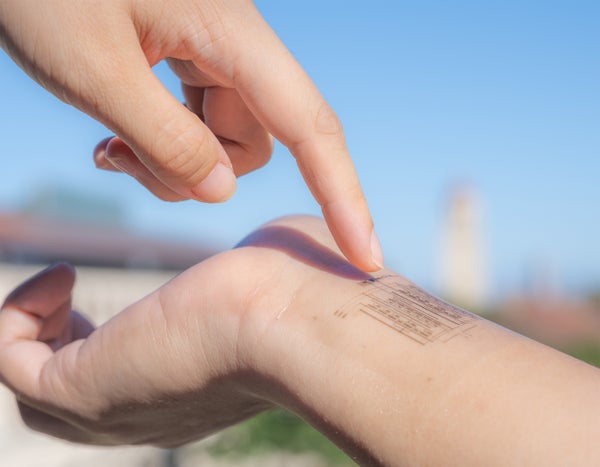Researchers have developed an electronic skin that can mimic the same process that causes a finger, toe or limb to move when poked or scalded. The technology could lead to the development of a covering for prosthetic limbs that would give their wearers a sense of touch, or help to restore sensation in people whose skin has been damaged.
The ‘e-skin’ was developed in the laboratory of chemical engineer Zhenan Bao at Stanford University in California. Her team has long been trying to make a prosthetic skin that is soft and flexible, but that can also transmit electrical signals to the brain to allow the wearer to ‘feel’ pressure, strain or changes in temperature.
The latest work, published on 18 May in Science, describes a thin, flexible sensor that can transmit a signal to part of the motor cortex in a rat’s brain that causes the animal’s leg to twitch when the e-skin is pressed or squeezed.
On supporting science journalism
If you're enjoying this article, consider supporting our award-winning journalism by subscribing. By purchasing a subscription you are helping to ensure the future of impactful stories about the discoveries and ideas shaping our world today.
“This current e-skin really has all the attributes that we have been dreaming about,” says Bao. “We have been talking about it for a long time.”
Sensitive skin
In healthy living skin, mechanical receptors sense information and convert it into electrical pulses that are transmitted through the nervous system to the brain. To replicate this, an electronic skin needs sensors and integrated circuits, which are usually made from rigid semiconductors. Flexible electronic systems are already available, but they typically work only at high voltages that would be unsafe for wearable devices.
To make a fully soft e-skin, Bao’s team developed a flexible polymer for use as a dielectric — a thin layer in a semiconductor device that determines the strength of the signal and the voltage needed to run the device. The researchers then used the dielectric to make stretchy, flexible arrays of transistors, combined into a sensor that was thin and soft like skin.
“We turned all the rigid materials into soft materials while still being able to have high electrical performance,” Bao says.
The sensor can turn physical changes, such as applied pressure or a change in temperature, into an electrical pulse. The team also made a device that can transmit electrical signals from nerves to muscles, mimicking connections in the nervous system called synapses.
Bao’s group tested the system in a rat. The skin was connected through a wire to the rat’s somatosensory cortex — the part of the brain responsible for processing physical sensations. When the e-skin was triggered by touch, it sent an electrical signal to the brain, which was then transmitted through the artificial synapse to the sciatic nerve in the animal’s leg, causing the limb to twitch.
Future developments
This type of e-skin could be used in people who have sustained major injuries, or have sensory disorders. Bao says that, in the long term, they hope to develop a less-invasive system. “We envision that for people who lost their limbs, we don’t have to implant into the brain,” she says. “We could have an implant in the peripheral nervous system.”
At present, the e-skin must still be wired to an external power source, but Bao hopes ultimately to develop a wireless device. However, to have a skin that covers all the fingers of the hand, and responds to touch, temperature and pressure, will require much more development, she says.
Still, having a closed-loop system going from sensation to muscle movement is “very exciting”, says Alejandro Carnicer-Lombarte, who researches bioelectronics at the University of Cambridge, UK. The device made by Bao’s team is “very much a proof of concept”, he says, but in the field of artificial prosthetics, many groups work on individual components — so bringing them all together in one system, as Bao’s team has done, is an important step forward. “Combining those things in sequence is not trivial, I’m very impressed by that,” he says.
Carnicer-Lombarte also sees a potential for integrating other known technologies into the system, to create, for example, a skin that enables the thumb and the little finger to sense different things. He adds that achieving greater sensitivity, so that specific brain regions can be targeted, will add to the utility of this technology in future.
This article is reproduced with permission and was first published on May 18, 2023.
